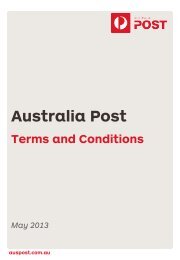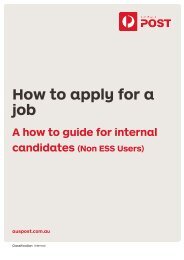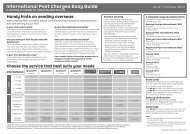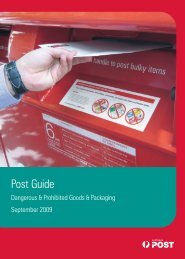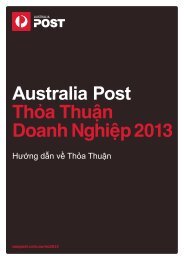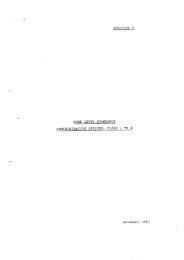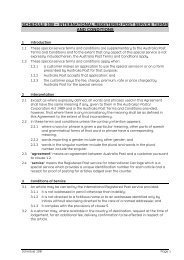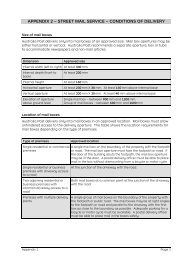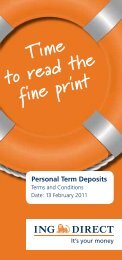2009-10 Annual Report - Australia Post
2009-10 Annual Report - Australia Post
2009-10 Annual Report - Australia Post
You also want an ePaper? Increase the reach of your titles
YUMPU automatically turns print PDFs into web optimized ePapers that Google loves.
28 Related parties (continued)<br />
transactions entered into directly by directors or director-related entities with the australian postal corporation have been either domestic or trivial<br />
in nature.<br />
For the year ended 30 June 20<strong>10</strong>, the corporation has expensed $14.5 million with respect to amounts owed by related parties (<strong>2009</strong>: $16.6 million).<br />
an impairment assessment is undertaken each financial year by examining the financial position of the related party and the market in which the<br />
related party operates to determine whether there is objective evidence that a related party receivable is impaired. When such objective evidence<br />
exists, the group recognises an allowance for the impairment loss.<br />
a number of directors of the australian postal corporation are also directors of other entities which have transacted with the australian postal<br />
corporation Group. these transactions have occurred on terms and conditions no more favourable than those which it is reasonable to expect the<br />
group would have adopted if dealing with any third party on normal commercial terms.<br />
ultimate controlling entity<br />
the commonwealth is the ultimate parent and controlling entity of the australian postal corporation Group. the australian postal corporation is the<br />
parent entity in the group comprising australia post and its controlled entities.<br />
29 Financial and capital risk management<br />
(a) Financial risk management objectives<br />
the corporation’s risk management policy is to identify, assess and manage risks, which are likely to adversely affect the corporation’s financial<br />
performance, continued growth and survival. in terms of financial and commodity risk management, the corporation will take a risk-averse approach<br />
to financial risk management in that it will seek to minimise risk, provided it is cost effective to do so.<br />
the group’s principal financial instruments, other than derivatives, comprise bonds, finance leases and hire purchase contracts, cash and short-term<br />
deposits. the main purpose of these financial instruments is to provide finance for the group’s operations. the group has various other financial<br />
assets and liabilities such as trade receivables and trade payables, which arise directly from its operations. the group also enters into derivative<br />
transactions, including interest rate swaps, forward currency contracts and commodity swap contracts. the purpose is to manage the interest rate,<br />
currency and commodity risks arising from the group’s operations and its sources of finance. it is, and has been throughout the period under review,<br />
the group’s policy that no trading in financial instruments shall be undertaken. the main risks arising from the group’s financial instruments are<br />
interest rate risk, liquidity risk, commodity risk, foreign currency risk and credit risk. the board reviews and agrees policies for managing each of these<br />
risks and they are summarised below.<br />
details of the significant accounting policies and methods adopted, including the criteria for recognition, the basis of measurement and the basis<br />
on which income and expenses are recognised, in respect of each class of financial asset, financial liability and equity instrument, are disclosed<br />
in note 1 to the financial report.<br />
(b) Capital risk management<br />
the group’s objectives when managing capital are to safeguard the ability to continue as a going concern while maximising the return to the<br />
commonwealth Government. the group recognises the impact on shareholder returns of the level of equity capital employed and seeks to<br />
maintain a prudent balance between the advantages and flexibility afforded by a strong capital position and the higher returns on equity possible<br />
with some leverage. a further consideration when managing capital is maintenance of an investment grade rating. the group holds a aa+rating<br />
(<strong>2009</strong>: aaa) from the independent ratings agency standard & poor’s.<br />
the capital structure of the group consists of debt, which includes the bonds payable disclosed in note 19, cash and cash equivalents disclosed in<br />
note 31(a) and equity attributable to equity holders of the corporation, comprising contributed equity, reserves and retained profits disclosed in notes<br />
22 and 23.<br />
the capital structure is reviewed annually as part of the corporate plan, which includes analysis of the return on equity, return on average operating<br />
assets and debt to debt plus equity ratios implicit in the corporate plan.<br />
AustrAliA <strong>Post</strong> AnnuAl rePort <strong>2009</strong>–<strong>10</strong> | Financial and statutory reports 85




